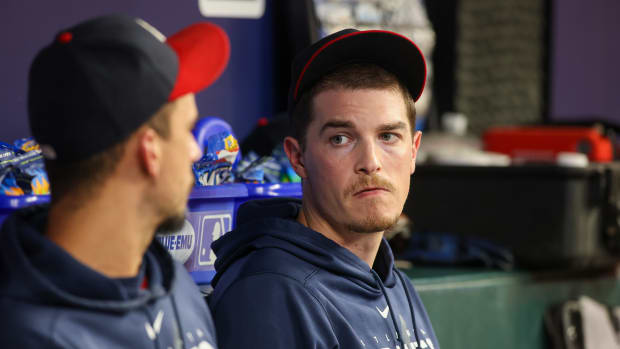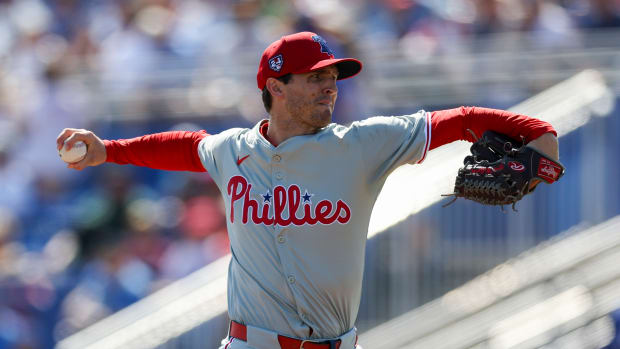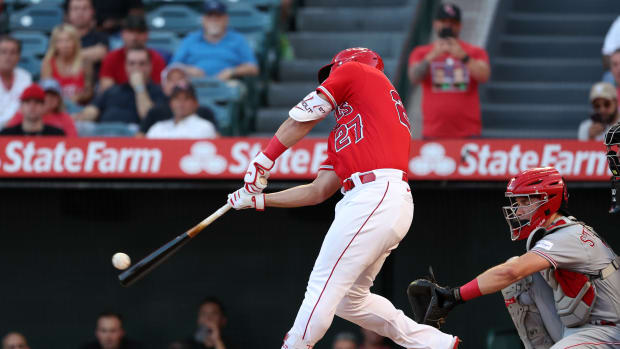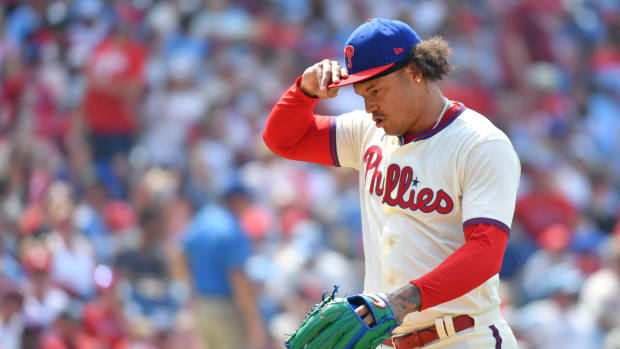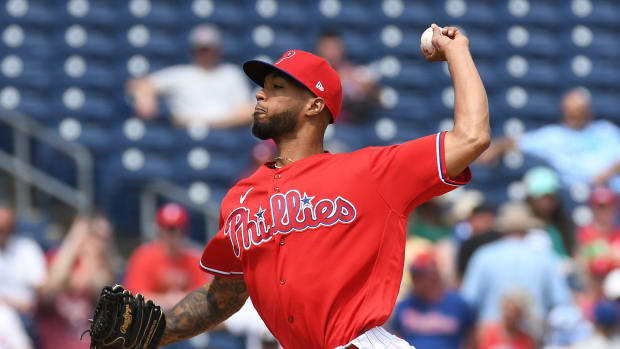Philadelphia Phillies' Vierling Needs to Improve His Plate Discipline
Matt Vierling has been getting plenty of playing time lately. Since right fielder Nick Castellanos strained his oblique on Sept. 2, Vierling has played in 12 of the Philadelphia Phillies' 14 games.
He has accrued 39 plate appearances in that time, and he is hitting .237/.231/.316 with a .547 OPS. To put it lightly, those aren't exactly great numbers. To put it not so lightly, those numbers flat out stink.
Part of the issue is that Vierling seems completely incapable of hitting right-handed pitching, but that's nothing new. The problem now is that even against lefties—the pitchers he is supposed to mash—the 26-year-old has failed to get the job done.
One of Vierling's biggest problems lately has been bad plate discipline against left-handed pitchers. You might have noticed his on-base percentage is actually lower than his batting average over the past 12 games, a rather rare feat even in a small sample.
Vierling has accomplished that feat by not walking at all in the month of September. Indeed, he has stepped to the plate 54 times since his last walk on Aug. 28.
Through the first half of the season, Vierling was walking 9.2% of the time, which ranked fifth on the Phillies (min. 10 PA) behind Kyle Schwarber, Rhys Hoskins, and Bryce Harper. In the second half, however, his walk rate has dropped precipitously. It now sits at just 4.3%, which ranks 11th on the team.
In particular, Vierling's walk rate against southpaws has plummeted. Through mid-July, he had a stellar 10.3% walk rate against lefties. Since the All-Star break, however, that number has fallen down to just 1.5%. In 66 PA versus left-handed pitchers, Vierling has walked only once.
Walks haven't always a big part of Vierling's game, but he began walking more last year, and that was one of the reasons why he shot up the team's depth chart and prospect rankings heading into the current season. Across 338 minor league plate appearances in 2021, Vierling walked 10.7% of the time. His 10.5% walk rate in 21 Triple-A games earlier this year was also a promising sign.
Therefore, it's fair to start worrying about Vierling's disappearing plate discipline. If he can't walk at an average-to-above-average rate, he might not be a very valuable offensive player.
So why isn't Vierling walking like that these days? It's a pretty simple answer really: he's swinging more. A lot more.
By swinging more often, Vierling is giving himself fewer chances to see balls and work up a hitter's count. He's also putting the ball in play more frequently, which means fewer plate appearances can end in a walk.
In the first half, Vierling swung at 39.2% of pitches he saw. That's quite a low swing rate. Only six NL batters (min. 150 PA) swung less often.
A low swing rate isn't necessarily a good or bad thing. Some of the very best hitters in baseball have a high swing rate, and some of the very best hitters have a low swing rate. In Vierling's case, however, his low swing rate was a sign of pretty good plate discipline.
He showed a strong ability to lay off balls outside the strike zone, swinging at such pitches just 26.7% of the time. The average MLB hitter has swung at 32.6% of pitches outside the zone this year.
Thus, Vierling only swung at 91 pitches outside the zone in the first half, while the average big leaguer would have swatted at 111 of those pitches. That made for plenty of extra balls Vierling earned through strong plate discipline.
In the second half, unfortunately, Vierling has no longer been able to lay off those pitches. Since the All-Star break, he has swung at 35.1% of pitches outside the zone. He has already swung at nine more balls than the average hitter would have.
With that in mind, it's no wonder Vierling's walk rate has dropped so steeply over the last couple months. If he wants to start walking more, he has to reign in his swing. That's easier said than done, of course, but at the very least it gives the young hitter a concrete goal to work towards. He isn't doing anyone any favors by making more contact at the expense of his OBP.
All plate discipline statistics courtesy of Baseball Info Solutions.
More From SI's Inside The Phillies:
- Phillies Star Bryce Harper Doesn't Hold Back on Thoughts About Joe Girardi
- How Mike Trout Will Join the Phillies
- Could Bryce Harper's Favorite MLB Player Join the Philadelphia Phillies Next Season?
- Why You Should Root for the Philadelphia Phillies to Lose a Few Games
- Phillies Release 2023 Regular Season Schedule
- Have the Philadelphia Phillies Found Their Centerfielder of the Future?
- Could The Phillies Soon Be Playing in Wawa Park?
- How did Philadelphia end up with Citizens Bank Park?
- How the Phillie Phanatic Came to be America's Favorite Sports Mascot
- Picking the Phillies' All-Time Single Season Lineup
Make sure to follow Inside the Phillies on Substack and Twitter!


